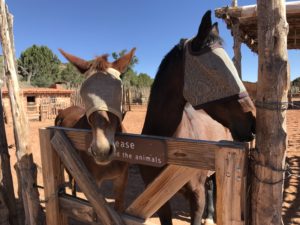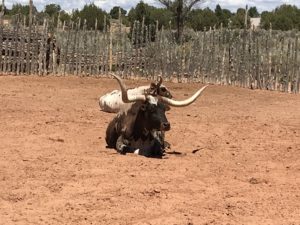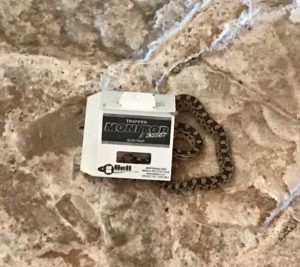We have animals at Pipe Spring National Monument! When Tom and I applied here, one of the things that caught my eye was working with the animals. Because all the rangers here cycle through all the duties, we are learning to care for the animals that live here at Pipe Spring.

The biggest attractions are a horse named Rowdy and a mule named Red. Red is 40 years old and took visitors up and down the Grand Canyon until he developed arthritis. Red is laid back and patient, trusting that you will get his food and his pain meds to him in a timely manner. Rowdy is only 18 years old and joined us from Bryce Canyon where they have horseback tours through the canyon. Poor Rowdy also suffers from arthritis, but his hit earlier than Red’s. Rowdy lives up to his name by trying to hog all the attention and eat Red’s food. Both Rowdy and Red love attention from visitors and will come over to the fence to check out whatever is going on.

Pipe Spring also has two resident longhorn cattle: Tess and Whit. Tess and Whit are brother and sister who came to Pipe Spring about 15 years ago. They are gentle and sweet and like attention as much as Red and Rowdy. Unfortunately they also have horns that live up to their name – long! One ranger got a concussion when he was standing too close to Whit and Whit turned his head suddenly. We have signs up all around their corral that say to stay back five feet but some visitors ignore the signs. When we bring their feed, we put it in the trough as quickly as possible before Whit and Tess come over to eat. Then we get out of their way!

Eight hens round out the animals at Pipe Spring. The hens are my favorites. I never knew chickens had so much personality. They are always waiting right by the door for their food in the morning. If someone forgets to feed them, the hens get louder and louder until the ranger remembers. They climb all over each other to get to their feed. We get four to seven eggs a day from them and anyone working that day can take them home to use.
The chickens like to roam so you never know where you will see them. I usually encounter them when I am giving my demonstrations in the afternoon by the spring. They come over to get some water, check out what I am doing, and then head out again. Four of the hens are Plymouth Rock chickens. The four of them hang out together and follow each other around.

We have other kinds of animals at Pipe Spring, but not on purpose. A coyote likes to keep an eye on the chickens and sometimes we herd the chickens quickly into the coop to get away from the coyote. We have lots of squirrels, chipmunks, and rabbits. We also have eight different kinds of lizards, but they move too fast for me to identify them.
Rattlesnakes are also common around the monument. Fortunately most of them are very shy and will disappear long before you notice them. We have seen a couple out sunning themselves. I just stomp a few times and they leave before we get close.

This last week, however, a baby Great Basin rattlesnake got caught in a sticky trap at the Fort. Recently I’ve heard from lots of people that baby rattlesnake bites are worse than adult snake bites, but this seems to be a myth. A trapped rattlesnake, no matter what its size, needs to be treated with respect. Josh, the ranger that discovered the baby rattlesnake, called the rangers trained in snake removal. They captured the snake and took it into the wild before releasing it. They had to spray it with denatured alcohol to get it unstuck, and the snake wasn’t very happy about that.
Rounding out the animals at Pipe Spring are the mice with hantavirus. Tom and I dealt with these at Death Valley so we know to be careful when we are around them. We check the traps every day in the Fort and Visitors Center and dispose of the mice when we find them. The other day I was giving a tour and noticed people weren’t listening to me. Instead they were watching the cutest little mouse you ever saw standing behind me. My inclination was to smash it under my boot. But instead I stomped and it ran off.
I like taking care of the animals that live at Pipe Spring. They add variety to the day and are always glad to see a ranger. I enjoy spotting the lizards, rabbits, and even the coyotes. But the rattlesnakes and mice are welcome to stay out of sight and far away.

One comment